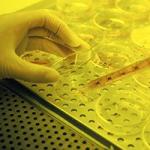
Ross William Cheloha, Ph.D.
Stadtman Investigator
Chemical Biology in Signaling Section, Laboratory of Bioorganic Chemistry
NIDDK
Research Topics
My research aims to develop new methods and tools applied to the study of biomolecules of interest, with a focus on designing new compounds for targeting cell surface receptors. My lab is particularly interested in the preparation of conjugates that consist of synthetic molecules and proteins. Towards this end, we develop new methods of protein preparation and conjugation, undertake medicinal chemistry campaigns, and perform pharmacological assays. These approaches focus on the pharmacology of G protein-coupled receptors, a family of proteins which constitute the target of over a quarter of approved therapeutics, with a specific emphasis on receptors relevant for the treatment of osteoporosis, diabetes, and inflammation. Findings from these studies will guide the rational design of therapeutics with improved properties.
Biography
- Postdoctoral Fellow, Boston Children’s Hospital and Harvard Medical School, 2017
- Postdoctoral Fellow, Whitehead Institute for Biomedical Research and Massachusetts Institute for Technology, 2015
- Ph.D., University of Wisconsin-Madison, 2015
Selected Publications
- Saha SJ, Cheloha RW. Chemically Induced Dimerization via Nanobody Binding Facilitates in Situ Ligand Assembly and On-Demand GPCR Activation. JACS Au. 2024;4(12):4780-4789.
- Sachdev S, Creemer BA, Gardella TJ, Cheloha RW. Highly biased agonism for GPCR ligands via nanobody tethering. Nat Commun. 2024;15(1):4687.
- Braga Emidio N, Cheloha RW. Semi-synthetic nanobody-ligand conjugates exhibit tunable signaling properties and enhanced transcriptional outputs at neurokinin receptor-1. Protein Sci. 2024;33(2):e4866.
- Cabalteja CC, Sachdev S, Cheloha RW. Rapid Covalent Labeling of Membrane Proteins on Living Cells Using a Nanobody-Epitope Tag Pair. Bioconjug Chem. 2022;33(10):1867-1875.
- Cabalteja CC, Sachdev S, Cheloha RW. Characterization of a Nanobody-Epitope Tag Interaction and Its Application for Receptor Engineering. ACS Chem Biol. 2022;17(8):2296-2303.
Related Scientific Focus Areas




Biomedical Engineering and Biophysics
View additional Principal Investigators in Biomedical Engineering and Biophysics

Molecular Biology and Biochemistry
View additional Principal Investigators in Molecular Biology and Biochemistry
This page was last updated on Thursday, August 7, 2025